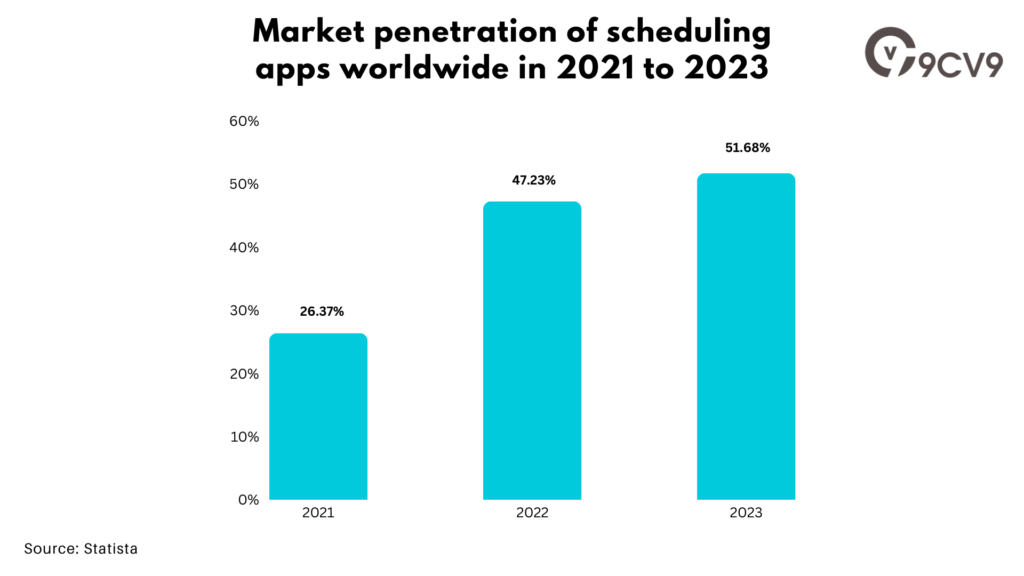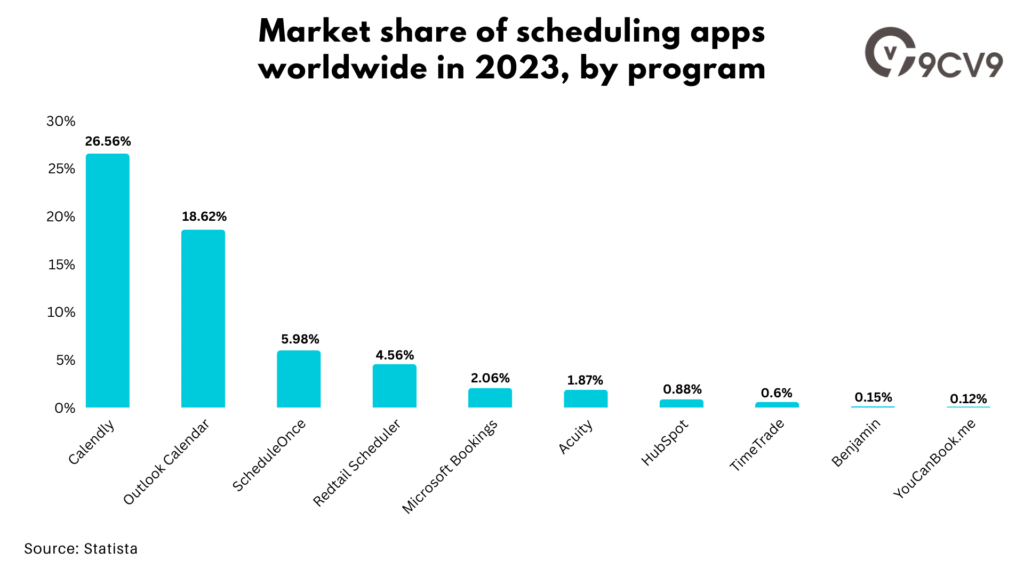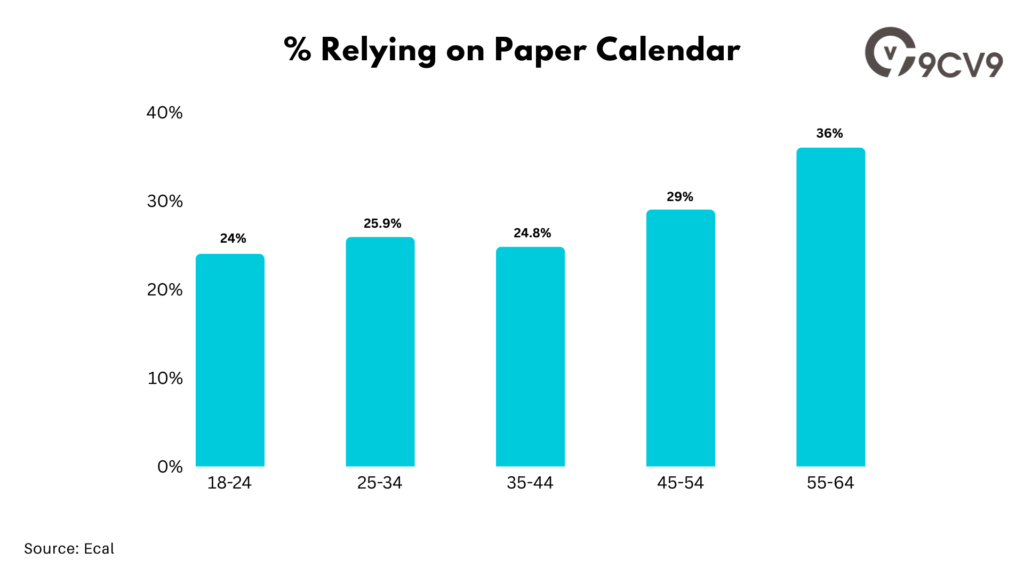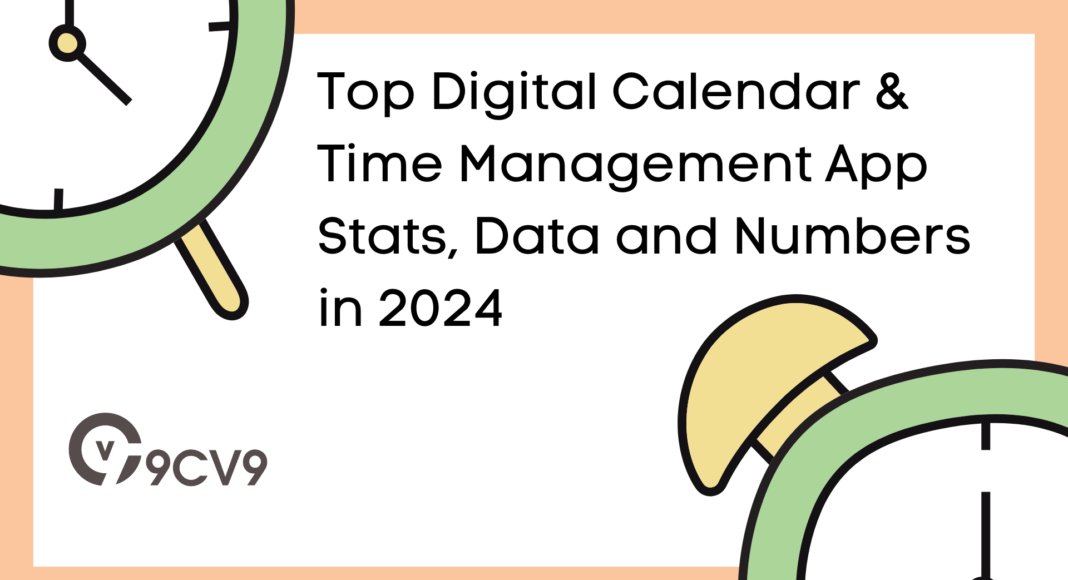Key Takeaways
- Enhanced Productivity: Discover how digital calendar and time management apps are revolutionizing productivity strategies with advanced features and intuitive interfaces.
- Market Insights: Gain valuable insights into the latest trends and statistics driving the digital calendar and time management app market in 2024, empowering you to make informed decisions.
- User Preferences: Explore the evolving preferences of users and businesses, uncovering key statistics on adoption rates, popular features, and demographic trends shaping the landscape of digital productivity tools.
In the ever-evolving landscape of productivity and time management, digital calendars and time management apps have become indispensable tools for individuals and businesses alike.
As we navigate the complexities of modern life, these digital solutions offer unparalleled convenience, efficiency, and organization, empowering users to maximize their productivity and stay on top of their schedules with ease.
In 2024, the digital calendar and time management app market continues to thrive, with an array of innovative platforms catering to diverse needs and preferences.
From intuitive scheduling features to advanced task management capabilities, these apps are revolutionizing the way we manage our time and resources in today’s fast-paced world.
In this comprehensive blog, we delve into the top 37 digital calendar and time management app statistics, data, and numbers for 2024.
Through in-depth analysis and insightful observations, we explore key trends, market insights, and user preferences shaping the landscape of digital productivity tools.
Whether you’re a busy professional seeking to optimize your workflow or a business owner looking to enhance team collaboration and efficiency, this blog serves as your ultimate guide to navigating the digital calendar and time management app market in 2024.
Join us as we uncover fascinating insights into market size and growth projections, user demographics, popular features, and much more.
From the dominance of industry leaders to the emergence of innovative newcomers, we provide a comprehensive overview of the digital calendar and time management app landscape, helping you make informed decisions and stay ahead of the curve in optimizing your productivity and time management strategies.
Get ready to dive deep into the world of digital calendars and time management apps as we explore the top 37 stats, data, and numbers shaping the industry in 2024.
Before we venture further into this article, we like to share who we are and what we do.
About 9cv9
9cv9 is a business tech startup based in Singapore and Asia, with a strong presence all over the world.
With over eight years of startup and business experience, and being highly involved in connecting with thousands of companies and startups, the 9cv9 team has listed some important learning points in this overview of the Top Digital Calendar & Time Management App Stats, Data and Numbers in 2024.
If your company needs recruitment and headhunting services to hire top-quality employees, you can use 9cv9 headhunting and recruitment services to hire top talents and candidates. Find out more here, or send over an email to [email protected].
Or just post 1 free job posting here at 9cv9 Hiring Portal in under 10 minutes.
Top Digital Calendar & Time Management App Stats, Data and Numbers in 2024
- The calendar app market is expected to more than 3x by 2030
- The calendar app market size is valued at around USD 6 Billion
- The global appointment scheduling software market size is valued at USD 470.7 million
- The global appointment scheduling software is expected to grow 3.3x by 2032
- Scheduling apps worldwide have a market penetration of 51.68%
- Calendly is the largest scheduling app with a 26.56% market share
- 70% of people in Australia rely on a digital calendar
- 46.7% of people in Australia rely most on their mobile calendar
- 23.3% of people in Australia rely on their desktop calendar
- 28.3% of people in Australia rely on paper calendars such as a diary, journal or planner
- Males in Australia are slightly more likely to use digital calendars than females
- 32.1% of females in Australia rely most on a paper diary, compared with just 24.6% of males
- Males (25.2%) rely on their desktop calendar more than females (21.3%)
- Apple is the most popular mobile calendar with 25.38% of all users
- Google is the most popular desktop calendar program with 15.44% of all users
- People in the 35-44 age group rely the most on Digital Calendars with 75.24% of them using it
- People in the 55-64 age group rely the most on Paper Calendars with 36% of them using it
- 40% of appointments are booked after business hours
- 67% of patients prefer online booking
- 26% of online appointments are for same-day or next-day appointments
- Only 33% prefer booking appointments by phone
- 54% of appointment bookings that occur during working hours are made on the go
- 34% of appointments that are scheduled online are done so after the office is closed
- Businesses gain an average revenue increase of 27% when using online booking systems
- Clients make 46% of all appointments online, while 54% are booked by staff
- More than 50% of Millennials and Gen X-ers say they would switch providers for the ability to book appointments online
- 41% of all booking services are found through social media
- 82% of clients use mobile devices to book appointments
- 60% of salons and spas can achieve up to a 60% online booking rate
- 68% of patients say they’re more likely to choose a medical provider that offers the ability to book, change, or cancel appointments online
- 72% of patients and 60% of healthcare professionals say online appointment booking platforms encourage patients to keep appointments
- 72% of Employers in the travel industry use online booking
- 29% is the percentage of reduction in no-shows with automated reminders
- Sundays from 4:00 to 8:00 p.m. is the most popular day and time to book appointments
- Half of Calendly’s users are based in the US
- Calendly has over 20 million users
- Google Calendar has over 1.2 billion monthly visitors
1. The calendar app market is expected to more than 3x by 2030
(Verified Market Research)
The calendar app market’s robust growth trajectory is underscored by its exponential rise in value, from USD 5.71 Billion in 2023 to a projected USD 16.37 Billion by 2030, representing a remarkable compound annual growth rate (CAGR) of 10.4% during the forecast period spanning 2024 to 2030. This anticipated tripling in value signifies a paradigm shift in how individuals and organizations approach time management and productivity enhancement. Such growth reflects an increasing reliance on digital tools for scheduling and organization, driven by the need for streamlined workflows and efficient resource allocation in today’s fast-paced world. Moreover, it signals a burgeoning market ripe with opportunities for innovation and market expansion, inviting both established entities and emerging players to capitalize on this transformative trend.
2. The calendar app market size is valued at around USD 6 Billion
(Verified Market Research)
The calendar app market, currently valued at approximately USD 6 billion, stands as a testament to the pervasive influence of digital productivity tools in modern-day life. This substantial valuation underscores the growing reliance of individuals and organizations on digital solutions for managing schedules, appointments, and tasks efficiently. With the advent of remote work and the increasing complexity of personal and professional commitments, the demand for intuitive and feature-rich calendar apps has never been greater. This valuation not only reflects the market’s present significance but also hints at its promising future, with ample opportunities for innovation and growth on the horizon. As the calendar app market continues to evolve and expand, it serves as a barometer of our collective dependence on technology to navigate the complexities of time management in today’s fast-paced world.
3. The global appointment scheduling software market size is valued at USD 470.7 million
(Fortune Business Insights)
In 2024, the global appointment scheduling software market commands a significant valuation of $470.7 million, marking a pivotal moment in the evolution of digital scheduling solutions. This substantial market size underscores the increasing reliance of businesses across various industries on sophisticated appointment management tools to streamline operations and enhance customer experiences. As organizations strive to optimize efficiency and adapt to dynamic market conditions, the demand for intuitive and feature-rich scheduling software continues to rise. This valuation not only reflects the current market landscape but also signals a promising trajectory of growth and innovation in the years ahead. With advancements in technology and shifting consumer expectations driving the evolution of appointment scheduling software, businesses are poised to leverage these solutions to drive productivity, improve resource allocation, and deliver exceptional service to their clientele.
4. The global appointment scheduling software is expected to grow 3.3x by 2032
(Fortune Business Insights)
The global appointment scheduling software market is poised for exponential growth, with projections indicating a remarkable 3.3x increase by 2032. Anticipated to surge from $470.7 million in 2024 to an impressive $1,550.8 million in 2032, this forecasted expansion underscores the pivotal role of digital scheduling solutions in modern business operations. With a projected compound annual growth rate (CAGR) of 16.1% during the period from 2024 to 2032, this growth trajectory reflects the escalating demand for sophisticated appointment management tools across diverse industries. As businesses prioritize efficiency, customer engagement, and operational excellence, the adoption of appointment scheduling software is expected to soar. This exponential growth not only reflects the market’s present significance but also signals a transformative shift in how organizations manage appointments, allocate resources, and optimize workflows. With technology driving innovation and market evolution, the global appointment scheduling software market is poised to play a pivotal role in shaping the future of business productivity and customer service excellence.
5. Scheduling apps worldwide have a market penetration of 51.68%
(Statista)

The evolution of scheduling apps within the digital landscape has been nothing short of remarkable, as evidenced by their escalating market share in recent years. In 2021, scheduling apps captured a notable market share of 26.37%, signaling their growing prominence in facilitating efficient time management and task organization. This figure experienced a substantial surge to 47.23% in 2022, underlining the increasing reliance of users on digital solutions for scheduling and appointment management. Building upon this momentum, scheduling apps continued their ascent in 2023, commanding an impressive market share of 51.68%. This upward trajectory reflects the ever-growing demand for intuitive and feature-rich scheduling apps, driven by the complexities of modern-day lifestyles and the need for streamlined productivity solutions. As scheduling apps continue to innovate and adapt to evolving user needs, their expanding market share solidifies their status as indispensable tools for individuals and businesses seeking to optimize their time management strategies and enhance overall efficiency.
6. Calendly is the largest scheduling app with a 26.56% market share
(Statista)

Calendly stands out as the dominant force in the realm of scheduling apps, boasting the largest market share of 26.56%. With approximately 1 in 4 scheduling app users opting for Calendly, it has firmly established itself as the go-to choice for individuals and businesses alike seeking seamless appointment management solutions. Following Calendly, Outlook Calendar claims the second position with a significant market share of 18.62%, further solidifying Microsoft’s presence in the digital scheduling sphere. Rounding out the top three is ScheduleOnce, capturing a notable market share of 5.98% with its versatile scheduling capabilities. Redtail Scheduler and Microsoft Bookings secure the fourth and fifth positions, respectively, with market shares of 4.56% and 2.06%, highlighting their popularity among users. Acuity, HubSpot, TimeTrade, Benjamin, and YouCanBook.me complete the top 10 list, each contributing to the diverse landscape of scheduling apps with their unique features and functionalities. As Calendly continues to lead the pack, the competition remains fierce among these top players, driving innovation and enhancing user experiences in the ever-evolving world of digital scheduling.
7. 70% of people in Australia rely on a digital calendar
(Ecal)
In Australia, the digital calendar has become an indispensable tool for a vast majority of individuals, with an impressive 70% of the population relying on its functionality to manage their schedules and organize their lives. This widespread adoption underscores the pivotal role that digital calendars play in facilitating productivity and time management in both personal and professional spheres. As technology continues to permeate every aspect of daily life, the convenience and accessibility offered by digital calendars have made them an integral part of the modern lifestyle for Australians. Whether it’s coordinating meetings, tracking appointments, or simply keeping track of important dates, the reliance on digital calendars reflects a broader cultural shift towards digitalization and the seamless integration of technology into everyday routines. As digital calendars continue to evolve and adapt to the changing needs of users, their prevalence in Australia is likely to remain steadfast, serving as a testament to their enduring value in an increasingly digital world.
8. 46.7% of people in Australia rely most on their mobile calendar
(Ecal)
In Australia, the mobile calendar has emerged as the preferred scheduling tool for a significant portion of the population, with a noteworthy 46.7% of individuals relying primarily on this digital platform to manage their time and commitments. This statistic underscores the profound influence of mobile technology on daily life, as smartphones have become ubiquitous companions for Australians navigating their busy schedules. The convenience and accessibility offered by mobile calendars enable users to stay organized and on track while on the go, empowering them to synchronize their personal and professional lives seamlessly. Whether it’s setting reminders, scheduling appointments, or accessing important dates from anywhere, the mobile calendar’s versatility and portability have made it an indispensable resource for millions of Australians. As mobile technology continues to evolve and integrate with various aspects of daily life, the reliance on mobile calendars is poised to remain strong, reflecting the ongoing convergence of digital innovation and lifestyle convenience in Australia.
9. 23.3% of people in Australia rely on their desktop calendar
(Ecal)
In Australia, the desktop calendar remains a significant tool for a notable portion of the population, with 23.3% of individuals relying on this digital platform to manage their schedules and appointments. Despite the prevalence of mobile devices, desktop calendars continue to serve as a trusted resource for users who prefer a more traditional approach to organizing their time. For many, the desktop calendar offers a familiar interface and robust functionality that cater to specific workflow preferences and professional requirements. Whether it’s managing complex schedules, coordinating team meetings, or accessing advanced features like task management and synchronization with other applications, the desktop calendar provides users with a comprehensive solution for their productivity needs. While mobile calendars may offer greater convenience and portability, the enduring popularity of desktop calendars among a significant segment of the Australian population highlights the diversity of preferences and the importance of choice in digital scheduling tools.
10. 28.3% of people in Australia rely on paper calendars such as a diary, journal or planner
(Ecal)
In Australia, the tradition of using paper calendars, such as diaries, journals, or planners, persists among a substantial 28.3% of individuals who rely on these tangible tools to manage their schedules and commitments. Despite the ubiquity of digital technology, many Australians still prefer the tactile experience and tangible benefits offered by paper calendars. For some, the act of physically writing down appointments and tasks helps to reinforce memory and foster a sense of organization and control over one’s schedule. Additionally, paper calendars offer a level of privacy and security that digital platforms may not always provide, appealing to those who prioritize data privacy and confidentiality. Furthermore, the creative freedom afforded by paper calendars allows users to personalize their planning experience, whether through doodles, stickers, or color-coding, adding an element of self-expression to the organizational process. While digital solutions continue to dominate the landscape, the enduring popularity of paper calendars among a significant segment of the Australian population underscores the timeless appeal of pen and paper in an increasingly digital world.
11. Males in Australia are slightly more likely to use digital calendars than females
(Ecal)
In Australia, there exists a slight gender discrepancy in the usage of digital calendars, with males being slightly more inclined to utilize these digital scheduling tools compared to females. While the difference may be subtle, it reflects nuanced preferences and habits within the population. Factors such as varying levels of comfort with technology, differing organizational strategies, and distinct lifestyle demands may contribute to this observed trend. For some males, digital calendars may align more closely with their preferred methods of organization and productivity management, offering convenience, flexibility, and advanced features tailored to their needs. However, it’s essential to recognize that individual preferences and habits vary widely across genders, and many females also rely heavily on digital calendars for managing their schedules. Nonetheless, this nuanced insight into digital calendar usage sheds light on the diverse ways in which individuals navigate their daily lives and underscores the importance of understanding and catering to diverse user preferences within the realm of digital technology.
12. 32.1% of females in Australia rely most on a paper diary, compared with just 24.6% of males
(Ecal)
In Australia, a notable disparity emerges in the preference for paper diaries between genders, with 32.1% of females relying primarily on this traditional scheduling tool, compared to just 24.6% of males. This discrepancy underscores distinct organizational preferences and habits among different segments of the population. For many females, the tactile experience and tangible nature of paper diaries offer a sense of control and familiarity in managing their schedules and commitments. The act of physically writing down appointments and tasks may serve as a cognitive aid, enhancing memory retention and providing a visual representation of their daily lives. Additionally, paper diaries often afford a level of privacy and security that digital platforms may not always guarantee, appealing to those who value discretion and confidentiality in their planning process. Conversely, while some males may also appreciate the simplicity and tangible benefits of paper diaries, they may be more inclined towards digital solutions that offer advanced features and technological conveniences. This nuanced insight into gender-specific preferences highlights the diversity of organizational strategies and underscores the importance of offering a range of scheduling options to cater to the varied needs of users within the Australian population.
13. Males (25.2%) rely on their desktop calendar more than females (21.3%)
(Ecal)
In Australia, there exists a discernible gender discrepancy in the reliance on desktop calendars, with 25.2% of males depending on this digital tool compared to 21.3% of females. This difference sheds light on the diverse organizational preferences and habits exhibited by different genders. For many males, the desktop calendar offers a familiar and convenient platform for managing their schedules and appointments, providing advanced features and customization options tailored to their needs. The desktop interface may align more closely with their workflow preferences and technological comfort, allowing for seamless integration with other productivity tools and applications. Conversely, while some females may also utilize desktop calendars for scheduling purposes, they may be more inclined towards alternative methods of organization, such as mobile or paper-based solutions. This nuanced insight into gender-specific preferences underscores the importance of understanding and accommodating diverse user needs within the realm of digital scheduling tools.
14. Apple is the most popular mobile calendar with 25.38% of all users
(Ecal)
Over the past 12 months in Australia, the landscape of mobile calendars has been dominated by three major players, with Apple, Google, and Windows Live emerging as the most popular choices among users. Apple’s native calendar app claims the top spot, commanding a significant share of 25.38% of all users. Known for its intuitive interface, seamless integration with other Apple devices, and robust features, the Apple Calendar app has become a go-to choice for many individuals seeking a reliable scheduling solution. Close on its heels is Google Calendar, capturing a substantial market share of 25.11%. Renowned for its cross-platform compatibility, collaborative features, and intelligent event suggestions, Google Calendar appeals to users across diverse devices and operating systems. Rounding out the top three is Windows Live Calendar, which secures a notable market share of 4.52%. While not as ubiquitous as its counterparts, Windows Live Calendar offers users a familiar and streamlined experience within the Microsoft ecosystem, catering to those who prefer Microsoft’s suite of productivity tools. As these popular mobile calendars continue to evolve and innovate, their widespread adoption underscores their indispensable role in facilitating efficient time management and organization for users across Australia.
15. Google is the most popular desktop calendar program with 15.44% of all users
(Ecal)
Among desktop calendar programs, several key players dominate the landscape in Australia, with Google leading the pack with a substantial 15.44% of all users. Renowned for its intuitive interface and seamless integration with other Google services, Google Calendar has become a staple for many individuals and businesses seeking efficient scheduling solutions. Following closely behind is Apple, capturing a notable market share of 7.77%. With its sleek design and seamless synchronization across Apple devices, the Apple Calendar app appeals to users entrenched in the Apple ecosystem. Additionally, Outlook secures a significant presence with 5.15% of users, leveraging its robust features and integration with Microsoft Office suite to cater to professional needs. Rounding out the list is Windows Live Calendar, which claims 4.76% of users, offering a familiar interface and seamless integration within the Microsoft ecosystem. As these desktop calendar programs continue to evolve and innovate, their widespread adoption underscores their indispensable role in facilitating efficient time management and organization for users across Australia.
16. People in the 35-44 age group rely the most on Digital Calendars with 75.24% of them using it
(Ecal)

In the realm of digital calendars, individuals in the 35-44 age group emerge as the most reliant cohort, with a substantial 75.24% of them utilizing these digital tools for managing their schedules and commitments. This statistic highlights the significance of digital calendars as indispensable aids in navigating the complexities of modern life, particularly for those in the prime of their careers and family responsibilities. The 35-44 age demographic often juggles a myriad of professional obligations, personal appointments, and family commitments, making the organizational capabilities offered by digital calendars invaluable. From coordinating work meetings to scheduling family events and managing personal tasks, these individuals rely on digital calendars to maintain efficiency, organization, and balance in their daily lives. As technology continues to evolve and digital solutions become increasingly integrated into daily routines, the prevalence of digital calendars among the 35-44 age group underscores their pivotal role in facilitating productivity and time management for individuals navigating the demands of adulthood and career advancement.
17. People in the 55-64 age group rely the most on Paper Calendars with 36% of them using it
(Ecal)

In the 55-64 age group, there is a notable reliance on paper calendars, with a significant 36% of individuals within this demographic favoring this traditional scheduling method. This statistic underscores a generational preference for tangible, tactile organizational tools among older adults, who may have grown accustomed to using paper-based systems throughout their lives. For many in this age group, paper calendars offer a sense of familiarity and simplicity, allowing for handwritten notes, annotations, and visual reminders that aid in memory retention and organization. Additionally, paper calendars often provide a level of privacy and security that digital platforms may not always offer, appealing to individuals who value discretion and confidentiality in their scheduling process. While digital solutions have become increasingly prevalent in today’s technology-driven world, the enduring popularity of paper calendars among the 55-64 age group reflects the diverse range of organizational preferences and habits shaped by generational experiences and lifestyle choices.
18. 40% of appointments are booked after business hours
(Zippia)
In today’s fast-paced and interconnected world, convenience is paramount, leading to a significant trend in appointment booking occurring outside traditional business hours. Recent data reveals that a substantial 40% of appointments are scheduled after standard business hours, reflecting the evolving needs and lifestyles of modern consumers. This shift can be attributed to various factors, including the rise of remote work, flexible scheduling options, and the proliferation of online booking platforms. With the increasing prevalence of smartphones and digital calendars, individuals now have the freedom to manage their appointments and commitments at any time, from virtually anywhere. This trend underscores the importance for businesses to adapt to changing consumer behaviors by offering flexible booking options and leveraging technology to facilitate seamless scheduling experiences beyond the confines of traditional office hours. By embracing this shift towards after-hours booking, businesses can enhance customer satisfaction, maximize operational efficiency, and capitalize on the growing demand for convenience in today’s digital age.
19. 67% of patients prefer online booking
(Zippia)
In the rapidly evolving landscape of healthcare, convenience and accessibility have become paramount considerations for patients seeking medical services. Recent data reveals a significant shift in patient preferences, with a staggering 67% expressing a preference for online booking systems. This trend underscores the growing demand for streamlined and user-friendly solutions that empower patients to schedule appointments at their convenience, without the need for time-consuming phone calls or office visits. Online booking platforms offer patients the flexibility to browse available appointment slots, select preferred healthcare providers, and confirm appointments in real-time, all from the comfort of their own homes or on the go. This preference for online booking reflects the broader digital transformation taking place across various industries, as consumers increasingly turn to digital solutions to meet their everyday needs. By embracing online booking systems, healthcare providers can enhance patient satisfaction, improve operational efficiency, and stay ahead of the curve in delivering patient-centered care in today’s digital age.
20. 26% of online appointments are for same-day or next-day appointments
(Zippia)
In today’s fast-paced world, the demand for immediate access to services extends to the healthcare sector, as evidenced by the significant statistic that 26% of online appointments are scheduled for same-day or next-day availability. This data highlights the increasing preference among patients for swift and convenient access to medical care, driven by various factors such as urgent health concerns, sudden illness, or the need for prompt medical attention. Online appointment booking platforms play a crucial role in meeting this demand, offering patients the flexibility to secure appointments without the constraints of traditional scheduling methods. By enabling same-day or next-day appointments, these digital platforms empower patients to take proactive steps towards addressing their healthcare needs promptly, thereby enhancing patient satisfaction and ensuring timely access to essential medical services. This trend underscores the transformative impact of technology on the healthcare landscape, as online booking systems continue to revolutionize the way patients interact with and navigate the healthcare system.
21. Only 33% prefer booking appointments by phone
(Zippia)
In an era characterized by digital convenience and instant access to information, the traditional method of booking appointments by phone has witnessed a decline in popularity, with only 33% of individuals expressing a preference for this method. This statistic underscores a broader trend towards digitalization in various aspects of everyday life, including healthcare and service provision. While phone-based appointment booking has long been a staple, many individuals now seek more efficient and streamlined alternatives that align with their busy lifestyles and evolving technological preferences. Online booking platforms offer patients the flexibility to schedule appointments at their convenience, bypassing the need for prolonged phone calls and potential wait times. By embracing digital solutions, healthcare providers and service professionals can enhance patient satisfaction, improve operational efficiency, and adapt to changing consumer behaviors in today’s digital age.
22. 54% of appointment bookings that occur during working hours are made on the go
(Zippa)
In today’s fast-paced world, the ability to manage tasks and appointments on the go has become increasingly important, as evidenced by the significant statistic that 54% of appointment bookings made during working hours occur while individuals are on the move. This data underscores the growing reliance on mobile technology as a tool for managing schedules and organizing daily activities, even amidst the demands of a busy workday. With the widespread adoption of smartphones and mobile applications, individuals now have the flexibility to schedule appointments conveniently, whether they’re commuting to work, running errands, or taking a quick break. This trend reflects a broader shift towards mobile-centric lifestyles, where individuals seek seamless integration between their personal and professional lives, leveraging technology to stay organized and productive wherever they may be. By accommodating the need for on-the-go appointment booking, service providers can cater to the evolving preferences of their clientele and enhance customer satisfaction in today’s dynamic and mobile-driven world.
23. 34% of appointments that are scheduled online are done so after the office is closed
(Zippia)
In the contemporary landscape of digital convenience, scheduling appointments online has become increasingly prevalent, with a noteworthy 34% of appointments booked through online platforms occurring after traditional office hours have ended. This statistic highlights the importance of flexibility and accessibility in modern healthcare and service provision, as individuals seek convenient solutions that align with their busy lifestyles and schedules. The ability to schedule appointments outside of regular business hours empowers patients to take control of their healthcare needs on their own terms, without being constrained by the limitations of traditional office hours. Online booking platforms offer a convenient and user-friendly alternative to phone-based scheduling, allowing individuals to secure appointments at their convenience, whether it’s late at night, early in the morning, or during weekends and holidays. By accommodating after-hours appointment scheduling, healthcare providers and service professionals can enhance patient satisfaction, improve access to care, and adapt to the evolving needs of their clientele in today’s 24/7 digital world.
24. Businesses gain an average revenue increase of 27% when using online booking systems
(Zippia)
The integration of online booking systems into business operations has proven to be a lucrative strategy, with businesses experiencing a substantial average revenue increase of 27%. This statistic underscores the transformative impact of digital technology on revenue generation and business growth. By offering customers the convenience of booking services or appointments online, businesses can streamline the booking process, reduce administrative overhead, and capitalize on the growing demand for digital solutions. Online booking systems empower customers to book services at their convenience, 24/7, without the need for phone calls or in-person visits, thereby expanding the potential customer base and driving revenue growth. Additionally, these systems often feature built-in tools for upselling, cross-selling, and marketing automation, further contributing to revenue generation. As businesses continue to adapt to changing consumer preferences and embrace digital transformation, the adoption of online booking systems emerges as a strategic investment with the potential to deliver significant returns in terms of increased revenue and sustained business success.
25. Clients make 46% of all appointments online, while 54% are booked by staff
(Zippia)
In the realm of appointment scheduling, there’s a notable division in how appointments are booked, with clients making 46% of all appointments online, while 54% are booked directly by staff. This statistic reflects a dual approach to appointment management, where both clients and staff play significant roles in scheduling activities. Online booking systems empower clients to take control of their schedules by offering convenient and accessible platforms to book appointments at their convenience. On the other hand, staff-assisted booking remains prevalent, particularly in sectors where personalized service or specialized expertise is required. Staff-assisted booking allows businesses to provide tailored assistance to clients, ensuring that their unique needs are met and appointments are scheduled accurately. By embracing both online and staff-assisted booking methods, businesses can cater to a diverse range of client preferences and operational requirements, ultimately enhancing customer satisfaction and optimizing scheduling efficiency.
26. More than 50% of Millennials and Gen X-ers say they would switch providers for the ability to book appointments online
(Zippia)
The digital era has fundamentally altered consumer expectations and behaviors, particularly among Millennials and Gen X-ers, as evidenced by the significant statistic that more than 50% of individuals within these demographic groups express a willingness to switch service providers for the convenience of booking appointments online. This data underscores the growing importance of digital convenience and accessibility in shaping consumer decisions, particularly when it comes to healthcare, personal services, and other service-based industries. For Millennials and Gen X-ers, who are accustomed to seamless digital experiences and value efficiency in their interactions with businesses, the ability to book appointments online is not just a preference but a determining factor in their choice of service providers. Online booking systems offer these tech-savvy consumers the flexibility to schedule appointments at their convenience, bypassing the frustrations of phone-based scheduling and administrative hurdles. By embracing online booking capabilities, businesses can not only attract new clients but also retain existing ones, demonstrating a commitment to meeting evolving consumer needs and delivering exceptional customer experiences in today’s digital age.
27. 41% of all booking services are found through social media
(Zippia)
In today’s interconnected digital landscape, social media platforms have emerged as powerful tools for discovering and accessing a wide range of services, as evidenced by the significant statistic that 41% of all booking services are found through social media. This trend underscores the growing influence of social media in shaping consumer behavior and preferences, particularly in the realm of service-based industries such as hospitality, wellness, and personal care. Social media platforms offer businesses a unique opportunity to showcase their offerings, engage with potential clients, and drive bookings through targeted advertising, influencer partnerships, and user-generated content. Additionally, platforms like Facebook, Instagram, and Twitter provide integrated booking functionalities, allowing users to seamlessly transition from discovery to booking without leaving the platform. By leveraging social media channels effectively, businesses can expand their reach, attract new clients, and capitalize on the power of social recommendations and referrals to drive bookings and revenue growth in today’s digital-first economy.
28. 82% of clients use mobile devices to book appointments
(Zippia)
In today’s mobile-centric world, the convenience and accessibility offered by mobile devices have revolutionized the way clients engage with businesses, as evidenced by the significant statistic that 82% of clients use mobile devices to book appointments. This trend underscores the pervasive influence of smartphones and tablets in shaping consumer behavior, particularly in the realm of appointment scheduling and service booking. Mobile devices provide clients with the flexibility to book appointments on the go, whether they’re at home, at work, or on the move, eliminating the need for cumbersome desktop computers or phone calls. Additionally, mobile-optimized booking platforms and apps offer a seamless and user-friendly experience, allowing clients to browse available services, select preferred appointment times, and confirm bookings with just a few taps. By embracing mobile booking capabilities, businesses can meet the evolving needs of their clientele, enhance customer satisfaction, and capitalize on the widespread adoption of mobile technology to drive bookings and revenue growth in today’s digital age.
29. 60% of salons and spas can achieve up to a 60% online booking rate
(Zippia)
The beauty and wellness industry has witnessed a significant transformation in recent years, fueled by the widespread adoption of online booking systems and the growing demand for convenience among clients. The statistic that 60% of salons and spas can achieve up to a 60% online booking rate underscores the increasing importance of digital solutions in streamlining appointment scheduling and enhancing customer experiences. Online booking platforms offer clients the flexibility to book appointments at their convenience, empowering them to browse available services, select preferred appointment times, and confirm bookings seamlessly. Additionally, the data revealing that 38% of spa and salon bookings are made for same-day appointments reflects the immediacy and spontaneity inherent in the beauty and wellness industry, where clients often seek last-minute treatments or self-care experiences. Furthermore, the fact that 88% of all appointments booked by women are with beauty salons and spas highlights the pivotal role of these establishments in catering to the specific needs and preferences of female clientele. By leveraging online booking systems and catering to the demand for same-day appointments, salons and spas can enhance customer satisfaction, optimize scheduling efficiency, and capitalize on the growing popularity of beauty and wellness services among consumers.
30. 68% of patients say they’re more likely to choose a medical provider that offers the ability to book, change, or cancel appointments online
(Zippia)
In the rapidly evolving landscape of healthcare services, patient preferences are shifting towards greater convenience and accessibility, as evidenced by the statistic that 68% of patients express a preference for medical providers that offer online appointment management capabilities. This trend underscores the growing importance of digital solutions in shaping patient perceptions and influencing healthcare provider selection. In today’s digital age, patients expect the flexibility to book, change, or cancel appointments online, empowering them to take control of their healthcare journey with ease and convenience. Furthermore, the data indicating that a significant number of individuals will overlook businesses that do not offer online booking options highlights the critical importance of digital accessibility in attracting and retaining clientele across various industries. By embracing online appointment management capabilities, medical providers can enhance patient satisfaction, improve access to care, and stay ahead of the competition in delivering patient-centered services that meet the evolving needs of today’s tech-savvy consumers.
31. 72% of patients and 60% of healthcare professionals say online appointment booking platforms encourage patients to keep appointments
(Zippia)
In the healthcare sector, the adoption of online appointment booking platforms has proven to be instrumental in encouraging patients to keep their scheduled appointments, as evidenced by the statistic that 72% of patients and 60% of healthcare professionals acknowledge the positive impact of these platforms. This trend underscores the transformative role of digital technology in promoting patient engagement and adherence to healthcare appointments. Online booking systems offer patients the convenience of scheduling appointments at their convenience, while also providing automated reminders about upcoming appointments. These automatic reminders, often sent via email or SMS, serve as valuable prompts for patients, helping to reduce no-show rates and improve appointment attendance. By leveraging online booking platforms and automated reminder systems, healthcare providers can enhance patient compliance, optimize scheduling efficiency, and ultimately improve healthcare outcomes. This seamless integration of technology into the appointment management process not only benefits patients by ensuring timely access to care but also enhances operational efficiency and workflow optimization for healthcare professionals.
32. 72% of Employers in the travel industry use online booking
(Zippia)
In the dynamic and fast-paced world of the travel industry, digital solutions play a pivotal role in streamlining operations and enhancing efficiency, as reflected by the statistic that 72% of employers in this sector utilize online booking systems. This high adoption rate underscores the industry’s recognition of the transformative impact of digital technology on travel-related services. Online booking platforms offer travel employers a convenient and centralized solution for managing bookings, reservations, and customer interactions, thereby streamlining processes and optimizing resource allocation. These platforms provide travelers with the flexibility to research, plan, and book their travel arrangements from anywhere, at any time, empowering them to take control of their travel experiences. Additionally, online booking systems offer employers valuable insights into customer preferences, booking trends, and market demand, enabling them to make informed decisions and tailor their services to meet evolving consumer needs. By embracing online booking platforms, employers in the travel industry can enhance customer satisfaction, drive revenue growth, and stay competitive in today’s digital marketplace.
33. 29% is the percentage of reduction in no-shows with automated reminders
(Zippia)
The utilization of automated reminders in appointment scheduling has demonstrated significant benefits, with a notable 29% reduction in no-shows attributed to their implementation. This statistic underscores the effectiveness of automated reminders in improving appointment attendance rates and optimizing scheduling efficiency. Automated reminders play a crucial role in ensuring that individuals remain informed and engaged with their appointments, particularly for those who schedule appointments amidst the busyness of their workday. In the midst of work responsibilities and other commitments, individuals may inadvertently overlook appointments, making automated reminders a valuable tool for mitigating no-shows and facilitating better time management. By sending timely reminders via email, SMS, or other communication channels, automated systems serve as proactive prompts that help individuals stay organized and accountable for their appointments. This not only benefits clients by reducing the likelihood of missed appointments but also enhances operational efficiency for service providers, ensuring smoother workflow and improved customer satisfaction.
34. Sundays from 4:00 to 8:00 p.m. is the most popular day and time to book appointments
(Zippia)
According to recent data, Sundays from 4:00 to 8:00 p.m. emerge as the most popular day and time for booking appointments. This trend reflects the shifting dynamics of scheduling behaviors, as individuals increasingly seek to balance their personal and professional lives while optimizing their leisure time. The popularity of Sunday evening appointments may be attributed to several factors, including the convenience of scheduling during non-working hours and the opportunity to unwind and prepare for the week ahead. Additionally, Sunday evenings often provide a relaxed and unhurried atmosphere, allowing individuals to dedicate time to self-care and wellness activities such as spa treatments, salon appointments, or medical consultations. By capitalizing on the demand for Sunday evening appointments, businesses can enhance customer satisfaction, improve booking efficiency, and maximize revenue potential by accommodating the preferences of their clientele.
35. Half of Calendly’s users are based in the US
(SignHouse)
As the digital landscape continues to evolve, Calendly has emerged as a frontrunner in the realm of digital calendar platforms, boasting a market share of over 25%. This impressive share underscores the platform’s widespread adoption and popularity among users seeking efficient and user-friendly solutions for scheduling appointments and managing their time. Calendly’s intuitive interface, seamless integration with various calendar systems, and robust features have positioned it as a go-to choice for individuals, businesses, and organizations across diverse sectors. Notably, a substantial portion of Calendly’s user base hails from the United States, with American users accounting for nearly half of all Calendly users worldwide, totaling 49.97%. This strong presence in the American market reflects Calendly’s success in catering to the needs and preferences of users in one of the world’s largest economies, highlighting its versatility and adaptability in meeting the diverse scheduling requirements of users across different regions and industries. With its market leadership and extensive user base, Calendly continues to innovate and redefine the way individuals and organizations schedule appointments, collaborate, and manage their time in today’s fast-paced digital landscape.
36. Calendly has over 20 million users
(Calendly)
With a staggering user base exceeding 20 million, Calendly has firmly established itself as a leading player in the digital scheduling arena. This remarkable milestone underscores the platform’s widespread adoption and popularity among individuals, businesses, and organizations worldwide. Calendly’s appeal lies in its intuitive interface, seamless integration with various calendar systems, and robust features designed to streamline the appointment scheduling process. As a versatile and user-friendly tool, Calendly empowers users to effortlessly schedule meetings, appointments, and events, while also facilitating seamless collaboration and coordination across diverse teams and stakeholders. The platform’s exponential growth in user numbers reflects its ability to meet the evolving needs and preferences of users across different sectors and regions, solidifying its position as a go-to solution for efficient time management and scheduling in today’s digital age. With its expansive user base and ongoing commitment to innovation, Calendly continues to redefine the way individuals and organizations approach scheduling and productivity, driving efficiency and collaboration in a variety of contexts.
37. Google Calendar has over 1.2 billion monthly visitors
(Similarweb)
Google Calendar stands as a cornerstone of digital time management, boasting an impressive user base of over 1.2 billion monthly visitors. This significant figure underscores the widespread adoption and reliance on Google Calendar as a go-to tool for scheduling and organizing events, appointments, and tasks across diverse contexts. As part of the Google ecosystem, Google Calendar seamlessly integrates with other Google services, such as Gmail and Google Drive, offering users a comprehensive suite of productivity tools to streamline their daily workflows. The platform’s user-friendly interface, robust features, and cross-platform accessibility make it a preferred choice for individuals, businesses, and organizations seeking efficient time management solutions. With its extensive reach and user base, Google Calendar continues to play an integral role in facilitating collaboration, coordination, and productivity for millions of users worldwide, reaffirming its status as a cornerstone of modern digital productivity.
Conclusion
As we conclude our exploration of the top 37 digital calendar and time management app statistics, data, and numbers in 2024, it’s clear that these digital solutions continue to play a pivotal role in shaping the way we manage our time and productivity.
From the staggering market growth to the evolving preferences of users, the landscape of digital calendars and time management apps is characterized by innovation, diversity, and opportunity.
In today’s fast-paced world, where time is a precious commodity, these apps offer a lifeline for individuals and businesses seeking to optimize their schedules, streamline workflows, and boost efficiency.
Whether you’re a busy professional juggling multiple commitments or a business owner striving to enhance team collaboration and productivity, the insights gleaned from this comprehensive analysis serve as valuable guidance in navigating the digital productivity landscape.
Looking ahead, it’s evident that the digital calendar and time management app market will continue to evolve, driven by advancements in technology, shifting user preferences, and emerging trends.
As new features are developed, and innovative solutions emerge, users can expect even greater levels of customization, integration, and automation to further streamline their productivity workflows.
As you incorporate these insights into your own productivity strategies, remember that the key to success lies not just in the tools you use, but in how effectively you leverage them to achieve your goals.
Whether you’re harnessing the power of AI-driven scheduling algorithms or simply adopting best practices for time blocking and prioritization, the ultimate goal remains the same: to reclaim control of your time and unlock your full potential.
We hope that this deep dive into the world of digital calendars and time management apps has provided you with valuable insights, inspiration, and practical strategies to enhance your productivity and achieve your objectives.
As you embark on your journey towards greater efficiency and effectiveness, may you find success, balance, and fulfillment in all your endeavors.
Thank you for joining us on this exploration, and here’s to a future filled with productivity, progress, and possibility.
If your company needs HR, hiring, or corporate services, you can use 9cv9 hiring and recruitment services. Book a consultation slot here, or send over an email to [email protected].
If you find this article useful, why not share it with your hiring manager and C-level suite friends and also leave a nice comment below?
We, at the 9cv9 Research Team, strive to bring the latest and most meaningful data, guides, and statistics to your doorstep.
To get access to top-quality guides, click over to 9cv9 Blog.
People Also Ask
How has the digital calendar market grown in 2024?
The digital calendar market has experienced significant growth in 2024, with an array of innovative apps catering to diverse needs.
What are the top features of digital calendar apps?
Top features include intuitive scheduling, task management, collaboration tools, and seamless integration with other platforms.
How do digital calendar apps enhance productivity?
Digital calendar apps boost productivity by organizing schedules, setting reminders, and facilitating efficient time management.
What are the key statistics driving the digital calendar market?
Key statistics include market size, growth projections, user demographics, and adoption rates among businesses and individuals.
What are the benefits of using time management apps?
Time management apps help users prioritize tasks, set goals, track progress, and optimize efficiency in their daily routines.
How do users integrate digital calendars into their workflows?
Users integrate digital calendars into their workflows by syncing with email, setting recurring events, and sharing calendars with colleagues.
Which demographic groups are driving the adoption of time management apps?
Millennials and Gen X-ers are among the demographic groups driving the adoption of time management apps due to their tech-savvy nature.
What are the popular time management strategies in 2024?
Popular strategies include time blocking, Pomodoro technique, Eisenhower matrix, and goal setting to maximize productivity.
How do digital calendar apps cater to remote work trends?
Digital calendar apps offer features such as virtual meetings, time zone management, and remote collaboration tools to support remote work trends.
What are the security considerations for using digital calendar apps?
Users should ensure data encryption, strong authentication measures, and privacy settings are in place to protect sensitive information.
How do digital calendar apps address accessibility needs?
Digital calendar apps offer accessibility features such as screen readers, keyboard shortcuts, and customizable layouts to accommodate diverse users.
What role do AI and automation play in digital calendar apps?
AI and automation enhance digital calendar apps with features like smart scheduling, predictive analytics, and natural language processing.
How do digital calendar apps support team collaboration?
Digital calendar apps facilitate team collaboration through shared calendars, group scheduling, and real-time updates on project timelines.
How do users balance personal and professional schedules using digital calendar apps?
Users balance schedules by color-coding events, setting boundaries, and allocating time for self-care and relaxation.
What are the emerging trends in digital calendar app design?
Emerging trends include minimalist interfaces, customizable layouts, and gamification elements to enhance user engagement.
How do digital calendar apps address user feedback and feature requests?
Developers regularly update apps based on user feedback, adding new features, fixing bugs, and improving usability.
What are the privacy implications of using digital calendar apps?
Users should review privacy policies, limit data sharing, and use secure connections to protect their personal information.
How do digital calendar apps integrate with other productivity tools?
Digital calendar apps integrate with email clients, task management software, and project management platforms to streamline workflows.
What are the best practices for setting up and maintaining a digital calendar?
Best practices include syncing calendars across devices, setting reminders, blocking distractions, and regularly reviewing schedules.
How do digital calendar apps help users achieve work-life balance?
Digital calendar apps support work-life balance by setting boundaries, scheduling downtime, and prioritizing self-care activities.
How do digital calendar apps address timezone differences in global teams?
Digital calendar apps offer timezone conversion tools, meeting scheduler, and world clock features to accommodate global teams.
What are the implications of digital calendar apps on mental health?
Users should be mindful of screen time, take breaks, and use digital calendar apps to organize tasks and reduce stress.
How do digital calendar apps cater to individuals with disabilities?
Digital calendar apps offer accessibility features such as voice commands, screen magnification, and customizable fonts for users with disabilities.
How do users personalize their digital calendar apps?
Users personalize apps with custom themes, event categories, preferred notification settings, and personalized reminders.
What are the trends in mobile calendar app usage?
Mobile calendar app usage trends include increased reliance on smartphones for scheduling, task management, and on-the-go productivity.
How do digital calendar apps help users track progress towards goals?
Digital calendar apps enable users to set milestones, track progress, and celebrate achievements to stay motivated and focused.
How do digital calendar apps contribute to remote learning and education?
Digital calendar apps support remote learning by scheduling classes, organizing study sessions, and setting reminders for assignments and exams.
How do users manage multiple calendars effectively?
Users manage multiple calendars by color-coding events, creating separate calendars for work and personal life, and using sync options to merge calendars.
Source:































![Writing A Good CV [6 Tips To Improve Your CV] 6 Tips To Improve Your CV](https://blog.9cv9.com/wp-content/uploads/2020/06/2020-06-02-2-100x70.png)


